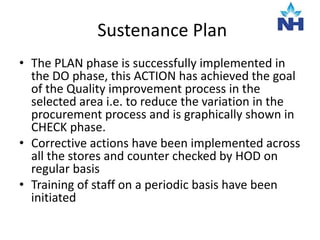QIP-SCM
- 1. QUALITY IMPROVEMENT PROJECT To Reduce the Variations in Procurement Process Prepared by Mr. Rajesh Manager – SCM, Shimoga
- 2. Introduction • Supply chain department in the hospitals are the veins of the organization through which all the requirements for patient care like consumables, medicines and surgical items are made available at right location right quantity and at right specifications with more cost effective
- 3. Problem Statement • Variations in the procurement process
- 4. Duration of the project • October 2015 – March 2016 (6 months)
- 5. Team Member • Mr. Rajesh – SCM Head • Mr. Jaypal – Deputy Manager SCM • Mrs. Prashanthi V – Store Executive • Ms. Pallavi K – Purchase Executive • Mr. Prateek Singh – Deputy Manager Quality
- 6. Data Collection 1.372% 1.151% 0.818% 2.000% 2.000% 2.000% 0.000% 0.500% 1.000% 1.500% 2.000% 2.500% Oct'15 Nov'15 Dec'15 % of variations from the procurement process Benchmark
- 8. loopholes • Unplanned requirement • Brand deviations • Change in the consumption pattern
- 9. PLAN AIM • To reduce the variation in the procurement process to 0% OBJECTIVE • To improve the procurement process of the materials in Supply chain department • To project the demand by running the PR tool at scheduled time • To follow up with the vendor
- 10. DO (Corrective action) • PR Tool - scheduled a proper slot to run the tool • Proper follow up with the vendor for the pending items either after the lead time or within the lead time • PR tool designed and has a track on – Exceptions – Alternates – ROL for VED • Timely payment to vendor
- 11. Planning through ABC Analysis
- 14. Vital drugs ROL
- 15. CHECK 0.500% 0.320% 0.270% 2.000% 2.000% 2.000% 0.000% 0.500% 1.000% 1.500% 2.000% 2.500% Jan'16 Feb'16 Mar'16 % of variations from the procurement process Benchmark
- 16. Sustenance Plan • The PLAN phase is successfully implemented in the DO phase, this ACTION has achieved the goal of the Quality improvement process in the selected area i.e. to reduce the variation in the procurement process and is graphically shown in CHECK phase. • Corrective actions have been implemented across all the stores and counter checked by HOD on regular basis • Training of staff on a periodic basis have been initiated
- 17. Conclusion • This PDCA model helped the SCM department to achieve its goal and as its one of the quality indicator the efficiency of the department has increased.

















